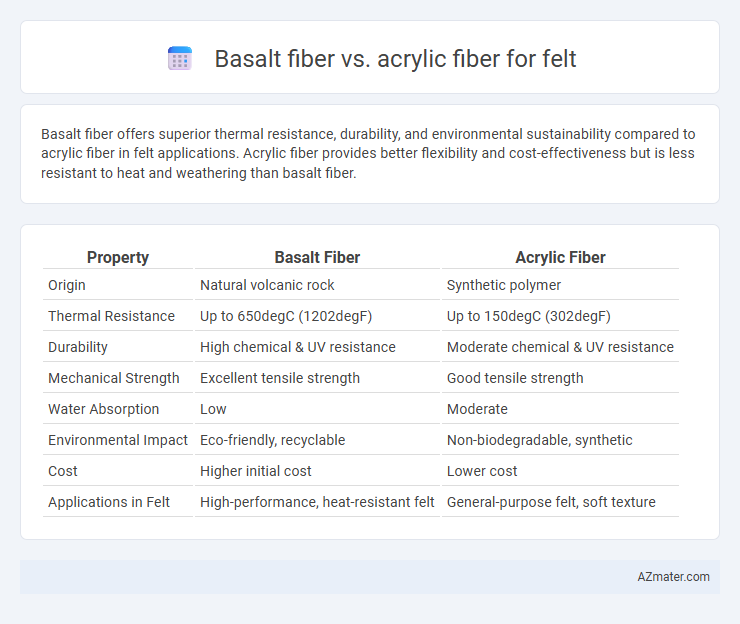Basalt fiber offers superior thermal resistance, durability, and environmental sustainability compared to acrylic fiber in felt applications. Acrylic fiber provides better flexibility and cost-effectiveness but is less resistant to heat and weathering than basalt fiber.
Table of Comparison
| Property | Basalt Fiber | Acrylic Fiber |
|---|---|---|
| Origin | Natural volcanic rock | Synthetic polymer |
| Thermal Resistance | Up to 650degC (1202degF) | Up to 150degC (302degF) |
| Durability | High chemical & UV resistance | Moderate chemical & UV resistance |
| Mechanical Strength | Excellent tensile strength | Good tensile strength |
| Water Absorption | Low | Moderate |
| Environmental Impact | Eco-friendly, recyclable | Non-biodegradable, synthetic |
| Cost | Higher initial cost | Lower cost |
| Applications in Felt | High-performance, heat-resistant felt | General-purpose felt, soft texture |
Introduction to Basalt Fiber and Acrylic Fiber
Basalt fiber, derived from volcanic basalt rock, offers exceptional thermal stability, high tensile strength, and resistance to chemical corrosion, making it an ideal choice for durable felt applications. Acrylic fiber, a synthetic polymer fiber made from acrylonitrile, provides excellent softness, color fastness, and resistance to UV radiation, commonly used for lightweight and flexible felt materials. Comparing these fibers highlights basalt fiber's superior mechanical performance and heat resistance against acrylic's ease of processing and vibrant aesthetic qualities in felt production.
Composition and Manufacturing Processes
Basalt fiber, derived from natural volcanic rock, is produced through a process of melting the raw basalt at approximately 1450degC and extruding it into continuous fibers, resulting in high mechanical strength and thermal stability. Acrylic fiber, primarily composed of polyacrylonitrile (PAN), is manufactured via a polymerization process followed by dry or wet spinning, offering softness and resistance to sunlight and weathering. The differing compositions--mineral-based basalt versus synthetic polymer acrylic--directly influence their manufacturing methods and end-use properties in felt applications.
Physical and Mechanical Properties
Basalt fiber exhibits superior tensile strength and higher thermal resistance compared to acrylic fiber, making it ideal for industrial felt applications requiring durability and heat protection. Acrylic fiber offers better flexibility and moisture-wicking properties but has lower abrasion resistance and tensile modulus than basalt fiber. The denser molecular structure of basalt fiber results in enhanced mechanical stability and longer lifespan under harsh environmental conditions relative to acrylic fiber.
Thermal Resistance and Stability
Basalt fiber exhibits superior thermal resistance compared to acrylic fiber, maintaining stability at temperatures up to 800degC, while acrylic fiber typically degrades around 150degC. This high thermal endurance makes basalt fiber felt ideal for industrial applications requiring fire resistance and sustained thermal insulation. The chemical stability of basalt fibers under extreme heat ensures consistent performance and durability, outperforming acrylic fiber in harsh thermal environments.
Chemical Resistance and Durability
Basalt fiber exhibits superior chemical resistance compared to acrylic fiber, maintaining structural integrity when exposed to acids, alkalis, and solvents commonly encountered in industrial felt applications. Durability-wise, basalt fiber outperforms acrylic with higher tensile strength and better thermal stability, resulting in longer service life under harsh environmental conditions. The enhanced chemical resistance and mechanical durability of basalt fiber make it a preferred choice for high-performance felt materials used in filtration and insulation industries.
Environmental Impact and Sustainability
Basalt fiber, derived from abundant volcanic rock, offers a highly sustainable alternative to acrylic fiber, which is petroleum-based and linked to significant environmental pollution. Basalt fiber production consumes less energy and emits fewer greenhouse gases compared to acrylic manufacturing, making it a greener choice for felt applications. Furthermore, basalt fiber is fully recyclable and biodegradable, whereas acrylic fibers contribute to microplastic pollution and have limited recycling options.
Cost Comparison and Availability
Basalt fiber for felt typically incurs higher costs due to its production complexity and limited manufacturing scale compared to acrylic fiber, which benefits from widespread industrial availability and lower raw material expenses. Acrylic fiber offers more cost-effective solutions for large-scale felt production, supported by established supply chains and global distribution networks. The limited availability of basalt fiber restricts its use primarily to niche applications where enhanced strength and thermal resistance justify the premium price.
Applications in Felt Production
Basalt fiber offers superior thermal resistance and mechanical strength, making it ideal for industrial and high-temperature felt applications such as insulation, filtration, and automotive components. Acrylic fiber is favored for felt production in textiles and apparel due to its softness, moisture-wicking properties, and excellent dye affinity, providing comfort and vibrant colors. The choice between basalt and acrylic fibers depends on the required durability, heat resistance, and end-use environment of the felt products.
Performance in Real-World Felt Products
Basalt fiber offers superior thermal resistance and mechanical strength compared to acrylic fiber, making it ideal for high-performance felt products exposed to extreme temperatures or mechanical stress. Acrylic fiber provides good flexibility and cost-efficiency, but lacks the durability and fire resistance of basalt fiber in real-world applications. Felt products made from basalt fiber demonstrate enhanced longevity and structural integrity under harsh environmental conditions.
Conclusion: Choosing the Right Fiber for Felt
Basalt fiber offers superior thermal resistance, chemical stability, and mechanical strength, making it ideal for high-performance felt applications in industrial settings. Acrylic fiber, while more cost-effective and lightweight, provides good flexibility and moisture resistance suitable for general-purpose felt products. Selecting the right fiber depends on the specific requirements for durability, temperature tolerance, and budget constraints in felt manufacturing.

Infographic: Basalt fiber vs Acrylic fiber for Felt
 azmater.com
azmater.com